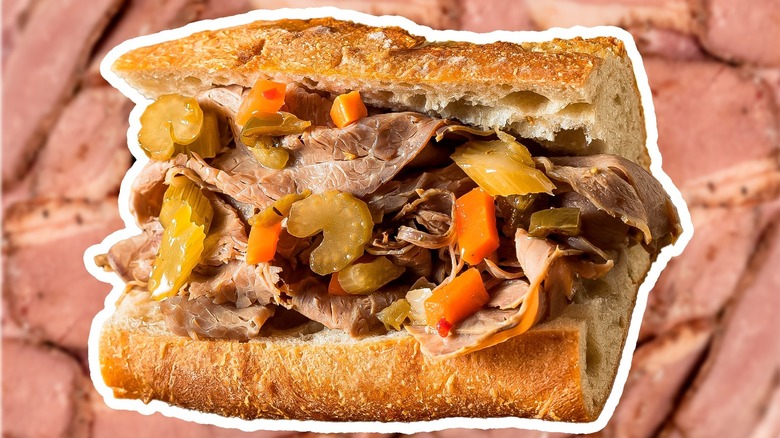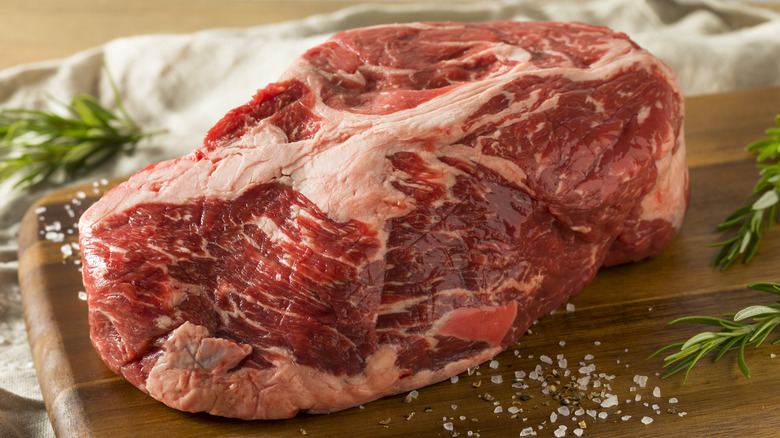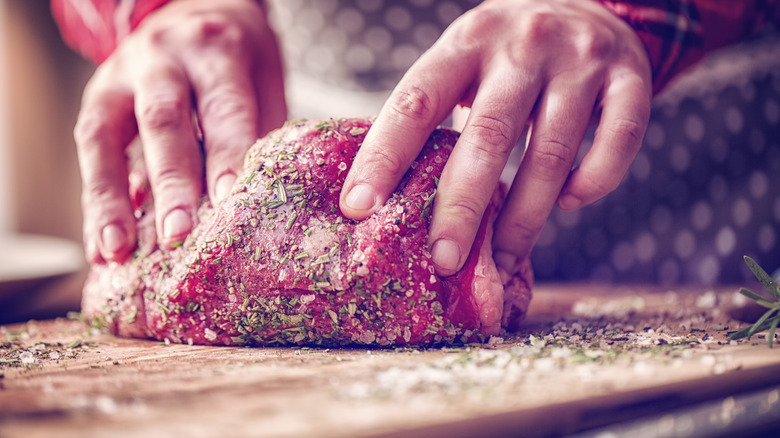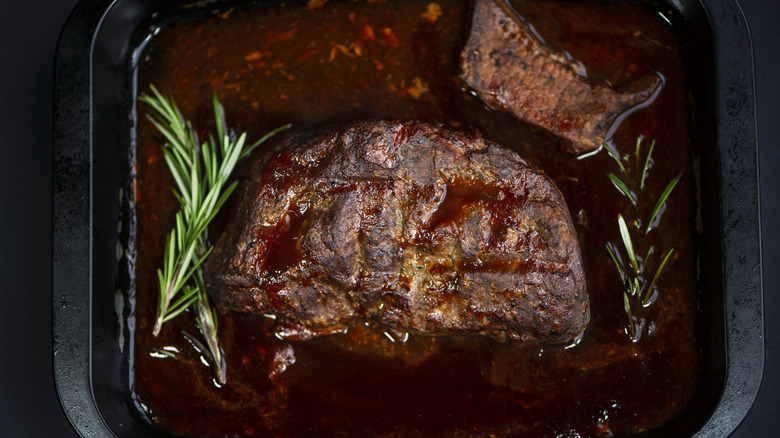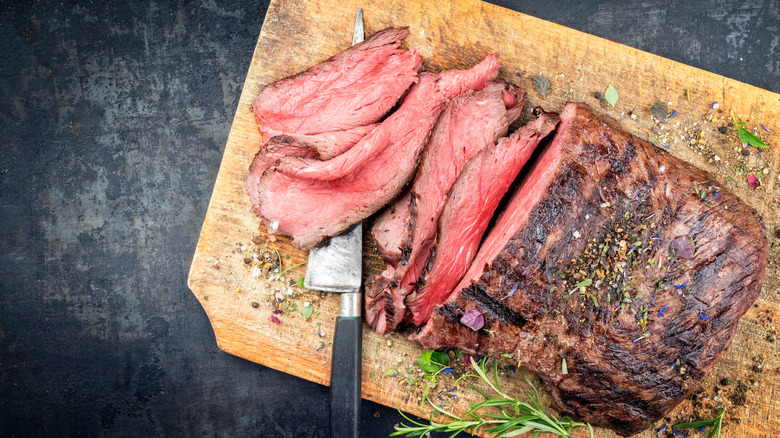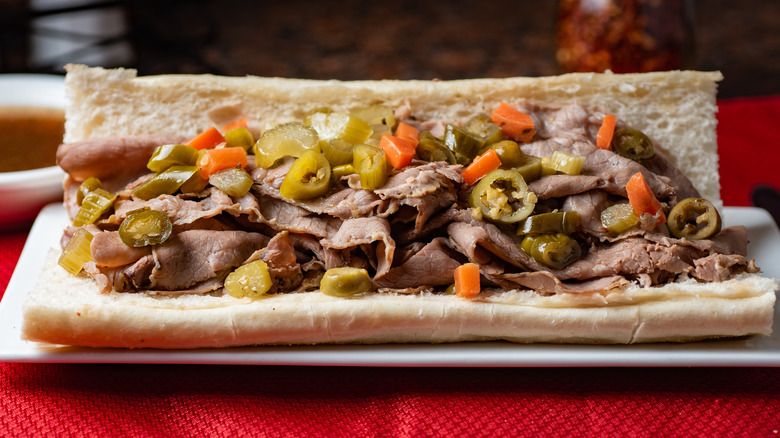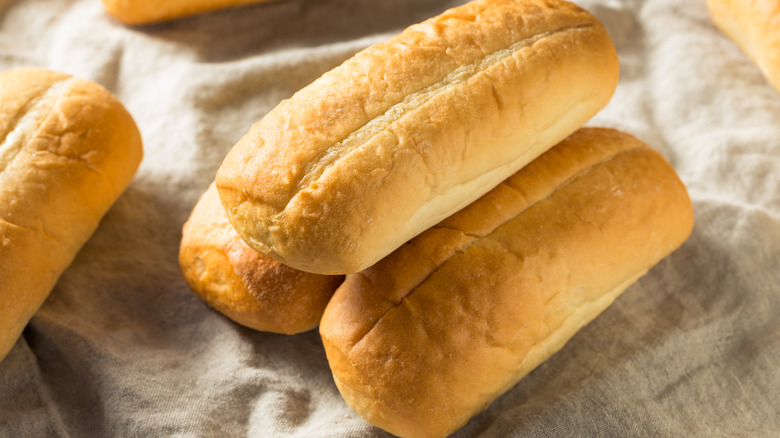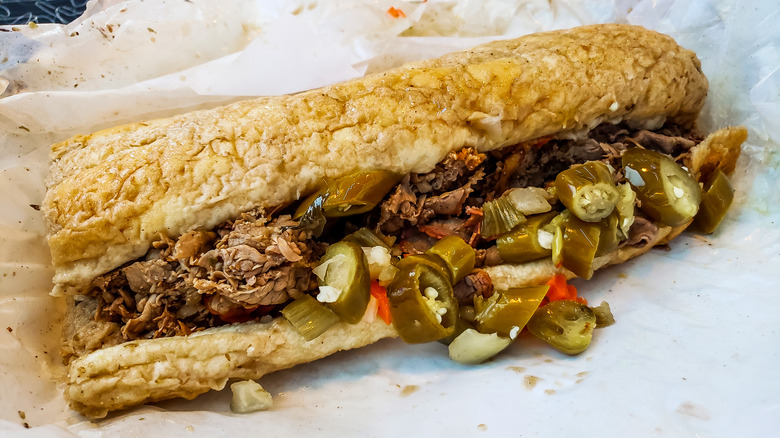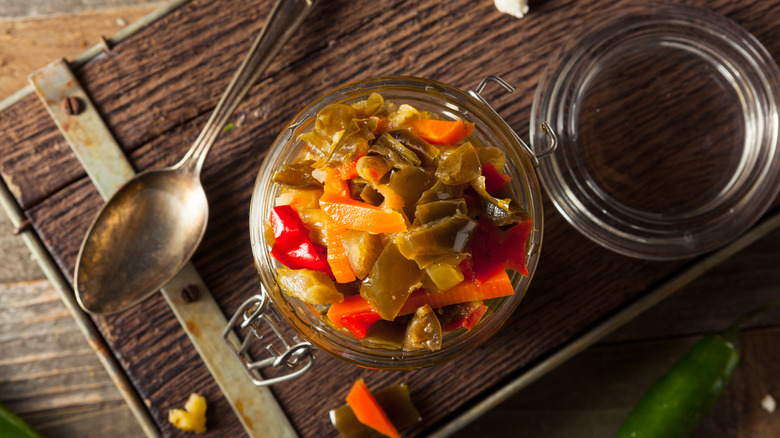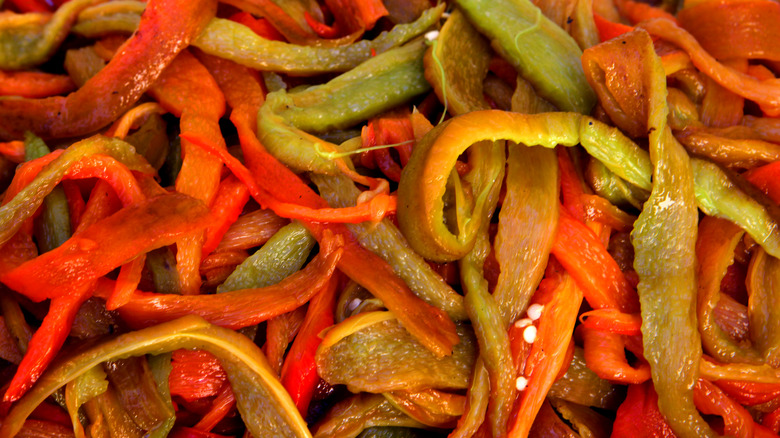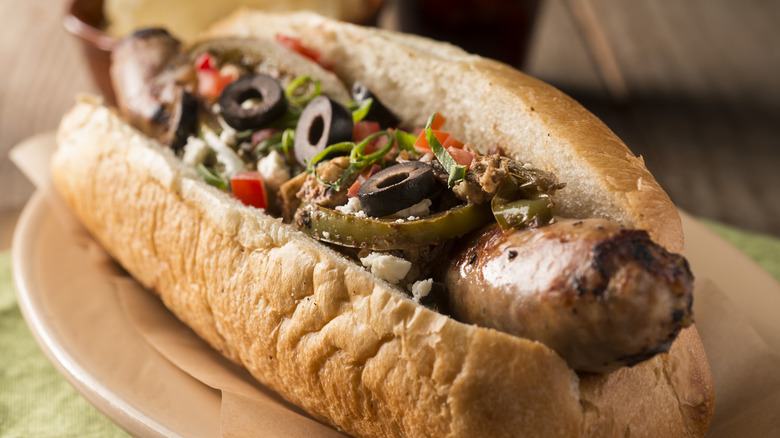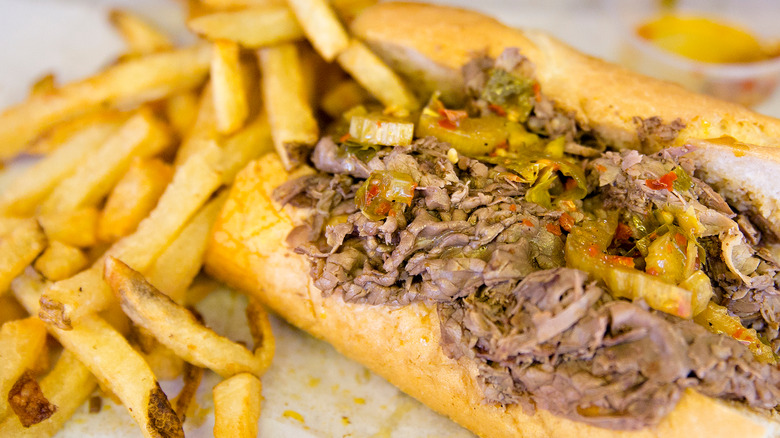14 Tips For Making A Truly Mouth-Watering Italian Beef Sandwich
The great city of Chicago boasts many unique signature foods that are celebrated the world over. Deep dish pizza, the Chicago dog, and rainbow cones are all proud Chicago culinary inventions. But the dish with the brightest spotlight on it right now, thanks to the sensational popularity of FX's "The Bear," is the Italian beef. Like many great regional sandwiches, the Italian beef seems simple on the surface: bread, beef, gravy, and toppings. But dig deep into each element and you'll find that making a great Italian beef takes an incredible amount of time, patience, and diligent work.
Making an Italian beef sandwich is not a job to be taken lightly. It's best to give yourself a few days to craft it properly — Al's Beef, considered by many to be the originator of the sandwich, spends 30 hours on its meat and gravy. But it's an undertaking that's worth the grind, especially if you live outside of Chicago and have trouble finding a local purveyor that's anywhere close to authentic. Just remember, this isn't a cheesesteak or a French dip, so keep the dairy far away and so don't skimp on the gravy. With some time and effort, you can create a sandwich that'll have you yelling "Yes, Chef!" with every salty, messy bite.
1. Start with the right cut of beef
The Italian beef is designed to take less desirable, tougher cuts of meat and turn them into mouthwateringly tender, juicy sandwich slices. There's not one specific cut of meat that's authentic to the Italian beef sandwich, so there is a little bit of leeway here. Courtney Storer, culinary producer on "The Bear," used chuck roast when demonstrating her version of the sandwich to the Los Angeles Times, yet mentioned top round and top sirloin as other valid options. Chuck comes from the shoulder of the cow and thus is quite a muscular cut with a deeply beefy flavor. A big chuck cut also boasts a fair amount of fat, which adds richness to the final product.
As for round, these cuts of meat come from the hind portion of the cow. These meats tend to be extremely lean with very little fatty marbling. You'll see top round and bottom round cuts — top designates that it comes from the inside leg, while the bottom is from the outside. Whichever cut you choose, all of these portions of beef need long cooking times to unlock their tender potential. Remember you're going to be slicing this, so a boneless cut is best.
2. Create your own seasoning blend
One thing that helps the Italian beef stand apart from other similar sandwiches is the aggressive seasoning. You don't want to just throw some salt and pepper on your beef and call it a day. This is a big, loud sandwich with intensity, and the way the meat is spiced and flavored is a huge part of its unique appeal. Each Italian beef joint has its own proprietary blend of herbs and spices, many of which are kept secret, so there are no shackles here. You can use a pre-made seasoning blend to keep it simple or come up with your own Italian seasoning mixture to put a signature spin on your sandwich.
A recipe based on the classic sandwich from one of the city's most legendary spots, Mr. Beef, was published in the Chicago Tribune in 1990. The seasoning mix consisted of equal parts red pepper flakes, garlic powder, dried basil and oregano, and ground pepper. Other dried herbs and spices like onion powder, ground fennel, rosemary, and paprika make good additions. Making your own blend allows you to regulate heat and flavor to your taste.
3. Season and sear the beef first
Before you get the beef cooking, there are two steps to take in order to maximize flavor. First, you want to take that Italian seasoning blend of yours and rub it all over the surface of the meat. Salt is key here, too — the longer salt is in contact with the meat's surface, the more time it has to pull out moisture, dissolve into that moisture, and sink back into the interior of the meat, seasoning it all the way through. This will ensure every slice of beef in your sandwich is flavorful.
Next, you want to brown the exterior of your beef. Getting a sear on it adds deep, caramelized flavor to the meat, creating more complexity and richness to both the meat and the gravy that will eventually be a key part of the sandwich. If you skip the browning step and just throw the raw meat in a pot, it'll still be perfectly edible, but the flavors will be one-note in comparison.
4. Cook with stock instead of water for more flavor
Once the beef is seasoned and seared, the real meat of the cooking process begins. In order to get leaner, tougher cuts of beef to reach their ideal tenderness, they need to stay moist or they'll dry out and become hard and chewy. That's why braising is the best course of action and will result in beef with the perfect texture for your sandwich.
To braise, you add liquid to the pot or pan that you're cooking your meat in. Rather than completely submerging the beef as you would if making a stew, you only fill the vessel part way. Any liquid or combination of liquids can be used in the braising process, from beer to wine to water. But if you want to give yourself a flavorful head start, use beef stock.
Whether you make your own or buy it from the store, it's guaranteed to intensify the taste of both your beef and your gravy. Store-bought stocks can be salty, so be aware of potential over-seasoning — you can usually find low sodium or no-salt-added versions just to be safe.
5. Take your time with low and slow cooking
Leaner, tougher cuts of meat like chuck and round need to be treated gently. Hotter temperatures can make these muscular hunks of beef toughen up even more, as the intense heat causes the meat's fibers to seize up and shorten. Low and slow cooking, on the other hand, allows these protein fibers to gently unravel, softening up the texture of the meat over time, leaving it nice and tender. When combined with a moist cooking method, like braising, collagen in the meat breaks down and gelatinizes the liquid, thickening it up and giving it luxurious richness.
Depending on the size of your cut of beef, ideal cooking times can vary greatly. You want to ensure the meat has reached a safe temperature — best to use a meat thermometer to be certain — as well as a tender texture, but you don't want to cook it so long that it completely falls apart. After all, it needs to be cut into slices eventually. It may take several hours, but the resulting tenderness and flavor are worth the time investment.
6. Cool the meat before thinly slicing it
Now comes the tricky part: the slicing. The key to extra tender, melt-in-your-mouth Italian beef is to get the slices paper thin. This is tough, if not nearly impossible, to achieve without a professional meat slicer. Of course, very few home chefs have one of these pieces of bulky and expensive machinery in their kitchens, but there are other creative solutions to get the beef sliced as thinly as possible using manual methods.
First, you never want to slice hot meat. Warm meat is soft and squishy, while cool meat firms up, giving you more stability. Therefore, once your beef is done cooking, you'll want to pull it out of its liquid and let it cool, preferably overnight in the refrigerator. A short stint in the freezer will make it even easier to cut precisely, although you don't want to let it freeze through — just enough to get it solidly firm, but still pliable enough to be sliceable.
It's also important to make sure your knife is laser sharp, and that you're slicing against the grain. Look for the direction the meat's fibers are lined up and cut through them, instead of alongside them. Releasing the tightness of the fibers makes every slice more tender.
7. Let the sliced beef swim in the juice
One of the secrets to the Italian beef's intense flavor and succulent, juicy texture has to do with this step. After the meat is seasoned, seared, cooked, cooled, and sliced, it needs to be reheated before the sandwich is assembled. The juices saved from the braising process strained into a pot, can be used for this purpose. Place the beef slices in the simmering liquid until they're warmed through, and finally, after all that time and work, the beef is ready to go.
Heating the meat up in liquid keeps it moistened, and the robustly flavored gravy gives it a final flavor boost before the sandwich takes its ultimate form. As long as the meat has been sliced thinly and against the grain, it should easily maintain its tenderness as it swims in the concentrated juices. At this point, it's good to taste the meat and gravy for seasoning and adjust if necessary.
8. Choose a roll with a soft interior and crusty exterior
Bread is always a key element of any sandwich, but with an Italian beef, it's even more crucial than most. Thanks to the generous juiciness of the gravy, the bread has to have a certain level of structure that stays intact, even when soaking wet. However, you don't want the bread to be too thick or too dense, or it'll overpower the flavor of the beef.
The consensus among most of Chicago's best-known Italian beef shops is that Turano, an Illinois-based baking company, makes the ideal French rolls for the sandwich. If you can't track down this specific brand, look for any kind of sandwich or hoagie roll that has enough substance to keep its shape and a decent exterior crust, but a spongy enough interior to properly soak up all the meaty juices. Italian beef sandwiches are best when the fillings are piled on liberally, so make sure your rolls aren't too truncated or narrow so they can handle a hefty heaping of filling.
9. Warm the bread first
The Italian beef is a warm sandwich — the beef and the gravy should be piping hot for the best enjoyment. So it only makes sense that the bread you serve it on should also be warm. Putting hot filling on a hot roll will keep the whole sandwich warm longer, giving you more time to enjoy it before it cools off. But heating the bread correctly can be tricky, as you don't want to change its fundamental makeup or texture too much.
Since you want to keep the interior of the sandwich soft and pliable so it can soak up the gravy, slicing and toasting the bread on the inside doesn't make sense. It's best to keep the rolls whole and warm them up in the oven just enough so that they heat up without drying out. Wrapping them in foil can help keep the exterior crust from burning or getting too tough. However, exposing the outside of the bread to a little dry heat will strengthen it a bit, making it sturdier and better able to withstand the moist filling.
10. Don't skimp on the gravy
An Italian beef sandwich is a shadow of itself without the gravy. The concentrated, meaty, and densely seasoned juices that cook with the beef are full of savory layers of flavor and should be generously applied to the sandwich along with the sliced beef. There are several ways that the gravy can be integrated into the sandwich depending on how much juiciness you're looking for, and some Italian beef terminology is helpful to know when it comes to this crucial element.
The main three styles involving gravy are dry, wet, and dipped. Dry means, just as it sounds, sans gravy. This is not a recommended way to enjoy the sandwich, as it's missing such a key part, and the sandwich will be rather arid without any sauce. Wet means that the interior of the bread has been lavishly ladled with gravy, and is the most common way to experience this sandwich. A dipped Italian beef has been doused, bread and all, into the gravy — some spots will even do an extreme version of a dipped sandwich, called baptized, in which the sandwich is thoroughly submerged so that every nook and cranny is soaked with meaty juice.
The nice thing about making your own Italian beef is that you can adjust your gravy to how you like it. And since you're enjoying the sandwich in the privacy of your own home, you can be as messy as you want, with no judgment.
11. Make your own giardiniera
The toppings on an Italian beef are simple and minimal — the beef should be the star and everything else there to enhance it. A traditional topping is what's known as giardiniera, a punchy pickled relish made from vegetables and peppers that adds heat and tang to the sandwich. This condiment was brought over by Italian immigrants to Chicago in the 1800s, and it evolved into different forms. Generally, it involves celery, cauliflower, carrots, and hot or sweet peppers (or a combination of both). These vegetables are chopped, pickled in vinegar, and preserved in olive oil.
With its acidic pop, this condiment cuts through the meaty beef and rich gravy to refresh your palate with each bite of the sandwich. It can be spooned on gently for a subtle flavor enhancement or slathered on if you like a fiercer bite. There are some good store-bought options out there, but making your own giardiniera allows you to customize its flavor and texture. You can go for mouth-searing heat or a zippier tanginess depending on what flavor profile you prefer. Either style complements the beef and gravy quite well, adding a nice contrast to the sandwich. When ordering from an Italian beef spot, the term "hot" is shorthand for giardiniera.
12. Top it with roasted peppers
If you're not a fan of giardiniera or pickled things in general, roasted sweet peppers are another traditional topping for Italian beefs. This choice is typically mellower and less intense than spicy, acidic giardiniera, but still adds a necessary dimension to the sandwich. Whereas "hot" is the ordering code for giardiniera at Italian beef joints, "sweet" is shorthand for this topping of cooked mild peppers. You can also order both "sweet" and "hot" for the ultimate combination of toppings.
Bell peppers are typical and are usually cut into long strips that lay across the length of the sandwich. They can be oven roasted or sauteed. Depending on your heat tolerance, you can up the spice factor in the peppers you use to get more of a kick by adding jalapenos or other hotter chilies. And leaving the seeds and membranes intact will add more spice intensity, too. If you prefer to keep it mild, make sure to carve away the membranes and deseed each pepper before you cook them.
13. Try it with a sausage
Variations that stray too far from the classic Italian beef are not generally tolerated by Chicago purists, but there is one that is so good it's hard to dismiss. Known simply as a "combo," this sandwich consists of everything that makes up the Italian beef with one addition: a whole Italian sausage.
The combo takes some of the spotlight off of the beef, which definitely changes the sandwich's personality. But the sausage brings its own flavor, fat, and intensity, making the sandwich an impressively decadent and meaty delight. If you've already taken the time and trouble to make your own beef, giardiniera, and peppers, and to get the bread just right, adding sausage to the mix is the easy part. Fans of a mellower sandwich should go for a sweet Italian sausage topped with beef and roasted peppers. For those who like more of a kick, a hot Italian sausage, beef, and spicy giardiniera make a scorching combo.
14. Serve and eat right away
An Italian beef sandwich is such an ephemeral piece of culinary magic. Days of effort go into creating it, and its ideal state of deliciousness lasts just a short amount of time. But during those few fleeting moments, while the beef, gravy, bread, and toppings dance together on the palate, each at the perfect temperature, it's one of the greatest and most unique sandwich experiences you can have. Perhaps one of the best things about making this sandwich at home is the ability to eat it immediately after it's formed, leaving only seconds between its assembly and ferocious enjoyment.
Because of its nature, this sandwich is not meant to be held for later. You can keep each element ready to go separately, but they should not be combined until eating is imminent. Put it together too early and you'll have soggy bread, congealed gravy, and cold beef. This iconic sandwich deserves to be enjoyed in its prime, so make sure you're ready.
